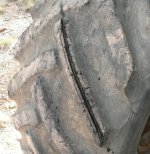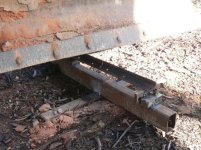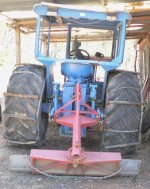Aussiebushman
Gold Member
- Joined
- Jul 31, 2008
- Messages
- 252
- Tractor
- Ford 6000
After partly hijacking another thread some time ago, it seemed best to start another one dealing with how to get better traction on my Ford 6000 in the bush and on rough dirt roads. The tyres are well worn - maybe 20% tread left and although forward traction was sortof OK, reverse was a constant problem because the wheels just slipped causing some interesting situations, to put it mildly. Because the tractor is used almost exclusively for scraping the bush roads and tidying up areas of scrub, the cost of $3 grand for new tyres could not be justified.
The info about siping on this forum was very useful but the technique doesn't seem to work on these surfaces. An alternative was chains and that might well have worked but since the tractor stays in the bush and will not damage the public roads, there was nothing to lose by going all the way to traction bars chained around the tyres.
The bars themselves were made from old star pickets, bent to the shape of the tyre using a simple jig and the weight of the front dozer blade for the downward bending force. For the first wheel, I welded angle brackets to each end with holes drilled in the brackets to shackle to the chains. When it came to working on the second wheel, just bending each end seemed simpler, though the metal is so soft, it tended to tear at the bend, so each bend was reinforced with some weld - seems OK
Getting the bars onto the chains was reasonably easy by draping the chains over the tyre and using shackles to attach each bar The spacing on the first wheel (the right hand side in the picture) is a bit rough and needs adjusting. The second wheel was a lot easier with shackles at the 12th link. The ends of each chain were pulled together and tension was applied by a couple of chains across the tyre wherever it seems necessary.
The result is good - plenty of traction, no side slip and best of all - a total cost of about $90 for chain and shackles. In one picture, you will see the tractor-driver's boss - Jenna, sitting proudly next to the wheel. If I had followed her instructions in the first place, the job would have been far easier
The info about siping on this forum was very useful but the technique doesn't seem to work on these surfaces. An alternative was chains and that might well have worked but since the tractor stays in the bush and will not damage the public roads, there was nothing to lose by going all the way to traction bars chained around the tyres.
The bars themselves were made from old star pickets, bent to the shape of the tyre using a simple jig and the weight of the front dozer blade for the downward bending force. For the first wheel, I welded angle brackets to each end with holes drilled in the brackets to shackle to the chains. When it came to working on the second wheel, just bending each end seemed simpler, though the metal is so soft, it tended to tear at the bend, so each bend was reinforced with some weld - seems OK
Getting the bars onto the chains was reasonably easy by draping the chains over the tyre and using shackles to attach each bar The spacing on the first wheel (the right hand side in the picture) is a bit rough and needs adjusting. The second wheel was a lot easier with shackles at the 12th link. The ends of each chain were pulled together and tension was applied by a couple of chains across the tyre wherever it seems necessary.
The result is good - plenty of traction, no side slip and best of all - a total cost of about $90 for chain and shackles. In one picture, you will see the tractor-driver's boss - Jenna, sitting proudly next to the wheel. If I had followed her instructions in the first place, the job would have been far easier



